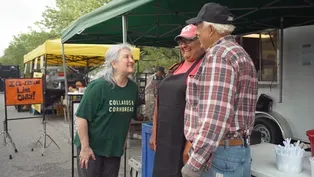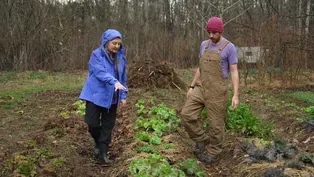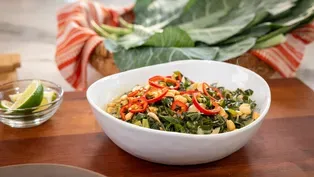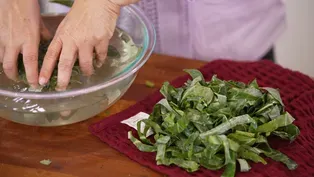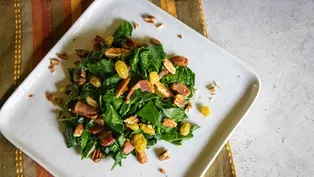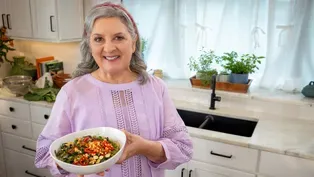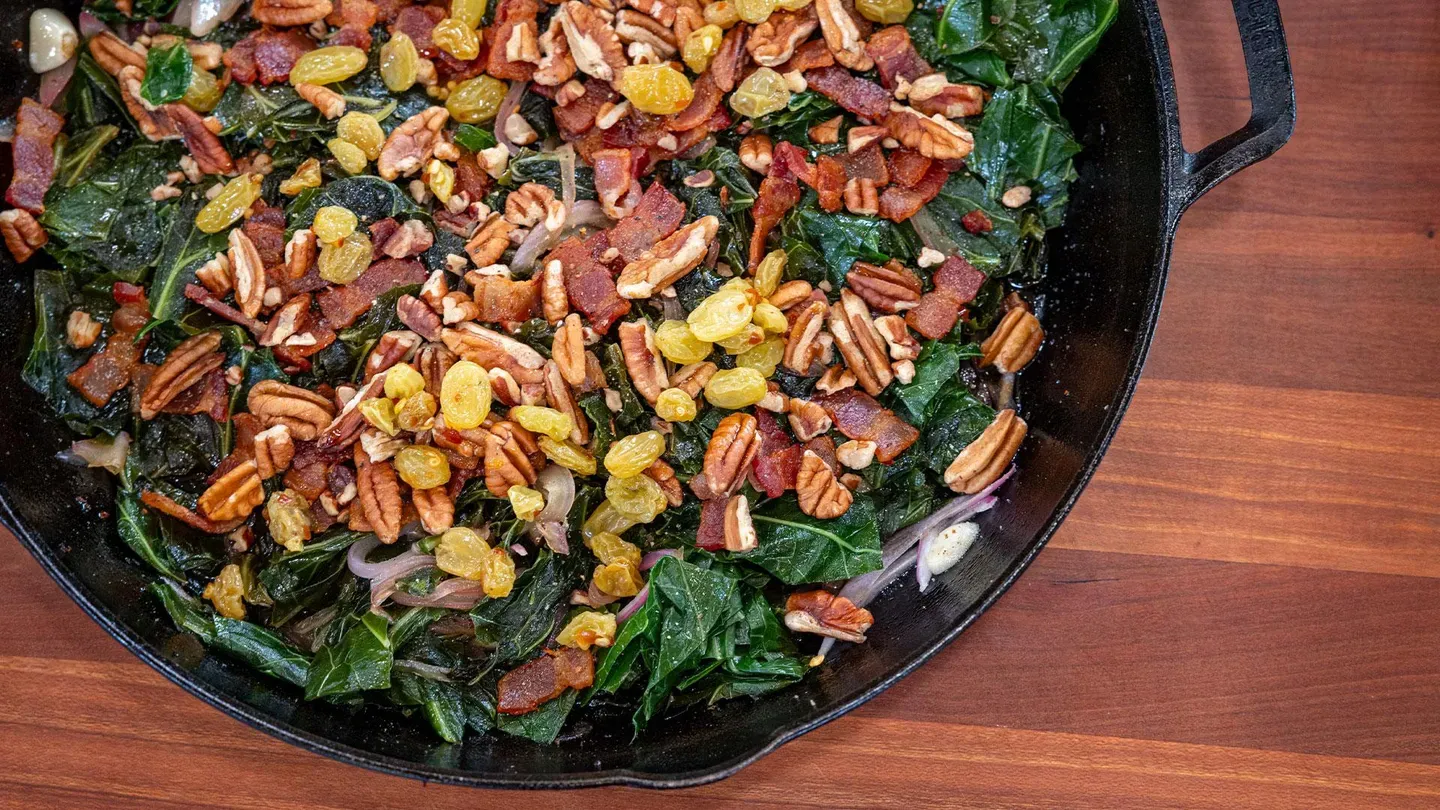

Turning Over a New Collard Leaf
10/1/2024 | 26m 46sVideo has Closed Captions
Host Sheri Castle offers a fresh look at a Southern favorite, collard greens.
Sheri offers a new take on collards with recipes for green curry and coconut creamed collards as well as collard salad with bacon dressing. She shares how to use every part of the leaf and explores an amazing range of collard varieties with Utopian Seed Project’s Chris Smith. Sheri then meets Glenn and Dorsey Hunt of the Lumbee Tribe at a street festival and makes their famous collard sandwiches.
Problems with Closed Captions? Closed Captioning Feedback
Problems with Closed Captions? Closed Captioning Feedback
The Key Ingredient is presented by your local public television station.

Turning Over a New Collard Leaf
10/1/2024 | 26m 46sVideo has Closed Captions
Sheri offers a new take on collards with recipes for green curry and coconut creamed collards as well as collard salad with bacon dressing. She shares how to use every part of the leaf and explores an amazing range of collard varieties with Utopian Seed Project’s Chris Smith. Sheri then meets Glenn and Dorsey Hunt of the Lumbee Tribe at a street festival and makes their famous collard sandwiches.
Problems with Closed Captions? Closed Captioning Feedback
How to Watch The Key Ingredient
The Key Ingredient is available to stream on pbs.org and the free PBS App, available on iPhone, Apple TV, Android TV, Android smartphones, Amazon Fire TV, Amazon Fire Tablet, Roku, Samsung Smart TV, and Vizio.
Providing Support for PBS.org
Learn Moreabout PBS online sponsorship[upbeat music] - [Announcer] This program was funded in part by The Forest at Duke, a retirement community in the heart of Durham, North Carolina.
With more than 350 residents, The Forest at Duke presents residents with ongoing opportunities to keep growing.
[upbeat music] - [Sheri] Coming up on "The Key Ingredient"... Today I'm introducing, or perhaps reintroducing you, to one of my favorite ingredients, collards.
I'll share two creative recipes that'll make you excited to give these leafy greens a fresh look.
We take a field trip to The Collard Patch with renowned seed saver, Chris Smith, and a cook along with my friends, Glen and Dorsey Hunt, to make their iconic collard sandwiches.
That's next.
[bright music] I'm Sheri Castle.
I write cookbooks.
I write for food magazines.
I cook, I teach, and I collect stories, and my favorite stories are the ones behind our best-loved home recipes.
That smells good.
You think bears are gonna come?
- Probably out here.
- [Sheri] Oh, that's awesome.
I will go out and explore from the ground up the best ingredients that go into some of our most beloved family recipes.
It's all about the food, the flavors, and finding "The Key Ingredient."
[bright guitar music] Chris Smith and his fellow farmers at The Utopian Seed Project are serious about collards.
They preserve historic varieties and develop new ones that can see us into future generations.
There's no better guide to walk me through a wintertime collar patch.
Hello, my friend.
- Hey Sheri.
- [Sheri] How are you?
- Very good, very good.
- [Sheri] It's good to see you.
Thanks for having me out today.
- I appreciate you coming out to the mountains.
- Yes, and I see that you arranged our mountain weather for us, a little rain here for a few minutes and so forth.
So I'm here to learn about collards.
- We have some collards to show you.
- Okay.
- Yep.
I run a project called The Utopian Seed Project.
We're at one of my board members houses, which is Yanna Fishman, and she's got this beautiful farm.
So I wanted to bring you here just to show you some of the collards that she was growing.
- [Sheri] How many collards are there in the world?
- Whoa, in the world, I don't know if I have that number, but in our world, then we have access to about 100 varieties of different collards.
- No kidding.
- Yeah, yeah.
- And are collards native to North America or where did they come from?
- Collards started off in Northern Europe.
They weren't really that well appreciated, but with the transatlantic slave trade, we had lots of African people being forcibly brought to the Southern United States, and they had a real appreciation of these dark leafy greens, but didn't have access to the foods of their cultures from Africa.
And we see collards being developed and appreciated as a true African American crop, which is pretty special in terms of American foodways.
- [Sheri] It seems to me that collards are one of the few greens that're available all year round, is that true?
- It depends on where you're growing.
Eastern North Carolina, you've got a full 12-month season on collards.
They're pretty cold-tolerant, so we've had multiple frosts here, and you can see the collards are alive and beautiful.
- Is there a size that these reach?
When you pick them, are the hearts tender?
How do you know when a collard is ready to pick?
- One of the beautiful things about growing greens is that it's edible from the tiniest sprout, depending on what you're doing with them.
When they're real small, they tend to be a little more tender.
As they get bigger, they tend to be a little bit tougher.
[bright music] - All right, I want you to show me how to pick a leaf here.
Do you cut 'em?
Do you pinch 'em?
- You can break them off at the stem.
They'll just snap off.
So these collards are so tender, you can eat them raw.
You can eat them raw at all stages, but the younger leaves are a little more tender, so I'll give you one of them.
That's a little baby one from the center.
Look at that.
Here we go, cheers.
- Cheers.
- Oh wow.
It's more tender than cabbage.
It's really sweet.
That is amazing.
Oh my goodness.
I'm a convert.
This is delicious.
- It's a whole new world of raw collards.
- A whole new world.
Why is it important to keep your diversity?
- So the environment and the climate is rapidly changing.
It's becoming way harder to grow food because of crazy weather events, spiked temperatures, early freezes.
And if we just have one variety that works in one set of conditions, then when those conditions change, that one variety can't cope.
But if we've got a huge amount of variety to choose from, then we can build more resilience into the food system, 'cause these might work in one set of conditions, but that variety over there might work in a different set.
And so when we have a whole food system with a myriad of different varieties and crop types, then we have a much stronger food system.
- That gives me some hope that some of those really old things might be what saves us in the long run, so I'm gonna keep eating collards.
- Yeah, they're delicious.
There's more to show you.
So, I've brought some collards from my other farm that I'd love to just show you all the different beautiful things.
- I'm here for it.
- Yeah, let's do it.
[bright music] So what I brought you here is an example of all those different varieties that I referenced before.
- Right, that looks like a flower arrangement.
It's gorgeous.
- Yeah, it's really pretty.
And there's just different leaf shapes and types.
So maybe I can just show you a few of the ones that excite me, or you can pick one out, and we can talk about it.
I mean, these purple ones are something that we've been looking at.
- It looks like red Russian kale, that's what I would think that was, but yet it's a collard.
- Yeah, usually with a collard, it's these smooth savoy-type shape, but this is deeply frilled, but it's still a collard.
- Look at this.
I'm gonna use this as a corsage.
- You really could.
So there's the deep purple ones that we've been looking at, but then look at this.
I'm gonna pull out the whole bunch.
There you go.
I feel like I should present it to you.
- No kidding, I know.
I feel like I've just won something.
- The textures in that leaf are just like- - It's beautiful.
- cosmic, actually.
We just love showing off to people that collards are more than just a basic green leaf.
There's all this beauty that you can explore, and people should get excited about that, so many things to explore.
- So many things to explore.
I'm in love with this one.
I'm going to wear it today.
- You can keep that one.
That one's yours.
- Thank you, thank you so much.
- And I'll give you some seeds.
- Thank you, thank you for your knowledge and for doing this.
I thought I knew collards.
I didn't know diddly squat.
Thank you.
- You know a little bit more.
- I do.
[upbeat jazzy music] - You know, when people think about collards, if they think about 'em at all, sometimes they think there's just one kind of collard and one way to cook 'em, but that is not true.
As we just saw at the farm with Chris, there are all kinds of collards with different colors and textures and aromas and flavors.
There's also lots of different ways to cook them, and I'm gonna show you a great one now.
I'm gonna make creamed collards in a green curry and coconut sauce.
This is how we get started.
This is coconut oil.
That's gonna be the fat I'm cooking these in.
Now over here I have the collard stems.
You know, sometimes people discard these stems, but they're actually edible.
They need a little bit more cooking than the leaves, so they're gonna go in the pot pretty soon.
[oil sizzling] Stir this around, got a good sizzle going.
And I'm gonna give these maybe a minute or two headstart over my other ingredients.
Let's talk about what those are.
I'm going to add shallots, get those stirred in.
Now I am using fresh ginger in this recipe that I chopped up myself.
The aroma of this is great.
The minute that ginger hit that coconut oil, it released its aroma, a great preview of the flavor to come.
So let's talk about this wonderful green curry paste.
It's a really easy product to buy.
You don't have to make this.
You could, but you certainly don't have to.
And all you have to do is put it in the pot and then stir it around.
And then I'm gonna put in a little bit of brown sugar.
Again, about a tablespoon is all you're going to need.
But once we put our collards in, we're gonna taste this and make sure everything is balanced.
Let's add one more thing.
This is fish sauce.
Now, I promise you that we are not gonna make this dish taste fishy.
I'm gonna put in about two teaspoons.
What fish sauce does is add what we call umami, that savory richness.
It's sort of like an underpinning for everything else.
Just a little bit is going to pull these flavors together.
It is time to add collards.
Now, I'm gonna add these.
You're not gonna think these are all gonna go in the pot.
I promise you they will.
I'm gonna add a little bit, stir it around, and let these wilt down before adding more.
Now this step of wilting these collards and letting them become beautifully vibrant green is an important, not only so they'll fit in the pot, but because we are building flavor.
This is coconut milk.
Now, coconut milk that I'm using for this recipe comes in a can, and when you pour it into the bowl, it looks a right mess, it separates.
That is not a problem, that's just what coconut milk does.
So all you need to do is to take a whisk and stir it until it comes back together.
Into the pot it goes.
Now let me stir this a little bit.
What I'm going for is I want tender collards, but I don't want slick ones.
They should be almost like aldente pasta.
They should be a little toothsome, but in no way should they be crunchy.
All right, gonna put the lid on.
The lid's gonna hold in some steam and help them cook a little bit more quickly.
Gonna let this hang out for a few minutes, and then we're gonna finish it up.
[bright music] This has been bubbling for six, seven minutes.
I think it's probably just right, and it is.
Look at that, that beautiful little bubble.
My collards have not lost any more volume, but they have turned just the right amount of tender.
But you know, I claim these were gonna be creamed collared, so I gotta do the last step.
I'm gonna add a thing called a corn starch slurry.
All a slurry is is when you take a little bit of cool water, and it needs to be cool water, and you add it to corn starch and make a little paste, a little liquid.
This is a slurry.
And the reason you take this step of dissolving the corn starch in the cool liquid is if we were to just sprinkle this corn starch in there, it is going to bead up and float around like little tiny pool toys on top and never do its job.
So cool water, warm liquid goes in and that's the way that you want it, and then we're gonna stir this in a little bit, and the magic happens.
When that cool slurry combines with this hot liquid and this hot food, look, already, you can tell that it is thickening up, and already we have finished this recipe.
It really is quick.
Look at how pretty this is.
Can you believe that that big billowy bowl of collards cooked down to this perfect amount?
Now, I lightly garnish this with two things.
I have some peanuts that I like to add for a little bit of salt and a whole lot of crunch.
Just sprinkle those right over.
And then for some color and that tiny bit of heat, I just cut up a red chili, and I'm gonna put these beautiful pieces over the top.
[upbeat music] I am so excited to taste this, and I've got one more little thing to do.
I am going to take a wedge of fresh lime and squeeze this beautiful juice over the top.
The bright citrus acidity of that lime is just what this needs to go with the coconut and curry, and I like to add it at the last minute so I don't lose one bright drop.
It is crunchy.
It's tender in the right spots.
I'm getting the green curry.
I'm getting the coconut.
I'm getting that lime.
You can taste everything in here, but then they come together to be something even more special.
This recipe makes me so happy.
It made me rethink leafy greens.
It made me rethink collards, and it's gonna make you think good things about it all.
[bright music] Collards and cornbread are a classic match, but in Eastern North Carolina, members of the Lumbee Tribe are known for turning that duo into delicious collard sandwiches.
My friends Glen and Dorsey Hunt are going to share some of their secrets to this signature treat that folks are willing to line up for just to get a bite.
Well, hey y'all.
- Hi, how are you?
- Good morning, my friends.
- Hey darling, how're you?
- I'm so happy to be here.
You know, I've eaten a few collard sandwiches, but I've never been on the other side of the table.
I am so excited to see how y'all go about this, because I hear there's nobody's better than the way y'all make 'em.
- You come to the right place.
- All right, well I'm hoping to be a helping hand today and not in your way, but whatever you tell me, I'm gonna listen.
- Well, you're wearing the right equipment.
- I know, can you believe this was in my closet already?
I was predestined for this day.
I've had this shirt for two or three years, but never a better occasion than right now.
- Right now.
- That's right, that's right.
We'll help ya get a little grease on it.
- Okie dokie, friends, let's get at it.
- [laughs] That's what I'm talking about.
- So, to do an event like this, how many pounds or bunches of collars, what do y'all have to do to get ready for a day like this?
- [Dorsey] Well, today we have 75 gallons.
- [Sheri] That's a bunch.
And so in your cooking them here, can you tell me, are they seasoned?
- [Dorsey] We put our meat grease in the pot, then we put the collards in there halfway frozen.
- So that's where your liquid's coming from?
- Yes, because collards make their own water.
- Collards make their own water.
How do you know when they're done enough?
Is that from tasting?
Can you tell by looking?
How do you know when they're sandwich ready?
- I taste them.
- Got any salt or anything?
- [Dorsey] We put salt in it.
We put a little bit of sugar in it.
- [Sheri] For balance, and so you're just cooking 'em down until they're thawed, until they're tender enough to suit you.
- [Dorsey] That's right.
- What do you think about people that put vinegar in their collards?
- A lot of people like to put vinegar on 'em, but we make something called chow chow.
- Oh, I love, okay, I just love how these look.
They're so bright green.
- Sheri, would you like to taste them?
- I am honored.
I am honored.
Let me get me a little bit here.
- Oh my goodness.
- [Glen] Taste test.
- Mm, that sugar is the key, man.
They've still got good chew to 'em.
They're not cooked to death, got that balanced sweetness, plenty seasoned.
I believe y'all have done this before.
- We have.
- [Glen] A little bit.
- Several times before.
- So good, so good.
The texture's what so good.
Oh, mercy, okay, onward and upward.
I can't wait to see what comes next.
- All right, next comes cornbread.
- Cornbread.
[bright music] So we can't have collards without cornbread.
And so you're gonna fry these all day long, and does it take two per sandwich?
- Two per sandwich.
- Okay.
- [Dorsey] So we put two pieces of corn bread.
- [Sheri] Two pieces of cornbread.
- [Glen] We're going to get some greens for that.
How about that?
- Now I noticed with these, when you take 'em outta the cooking pot, you leave any liquid behind, so that these are are drier, right?
- That's right.
- Okay.
- These are drier, we're gonna put them on 'em and spread 'em out a little bit, yes ma'am.
- Okay, and then this is all that goes in the middle?
- Yes ma'am.
- All right.
So close it up, scooch it to the middle a little bit.
All right, so this is fatback, white bacon.
- That's fat back.
- And you fried this till it was crisp.
- Right.
- And how many pieces?
One, two- - Two.
- Two, two pieces, all right.
[playful music] - [Dorsey] You did a good job.
- [Glen] She's done a done job.
[everyone laughs] - Lemme see if I can get all this up in here and get a bite.
You've got that crisp, tender cornbread.
You've got that super crunch, porky taste from this.
But then you've got those tender, perfect, but not soupy, collards.
- [Glen] That's right.
- [Sheri] That is a genius way to eat collards and cornbread.
- [Dorsey] Yes, it is.
- What y'all have done is you've taken the perfect collard experience and made it so you can walk around with it.
This is collard perfection on the hoof.
- [Glen] That's right.
- Well, I have learned so much.
This is so delicious, and I cannot thank you enough.
- I'm glad you enjoyed it.
We're glad to have you down to eat one.
- I'll be back.
- I'd like to see all my friends come down to eat collards.
- Well, now you're stuck with me, 'cause I'm come back every time.
[Glen speaking indistinctly] [laughing] Thank y'all.
- I believe it.
I love it.
- You're very welcome.
- All right, thank you.
- You're welcome.
- I know you got people lining up.
I gotta get outta your way.
- Yeah, they're lining up.
- All righty, thank you.
[upbeat music] - So when I was growing up in the mountains of North Carolina, my family often ate what we called wilted salads or killed lettuce salads.
And I've always loved that flavor combination of greens with a little bit of a warm dressing, and that's what I'm gonna do with collards today.
It is a great way to get traditional flavors in a very contemporary collard recipe.
But sometimes collards are a little more mature, and they're going to need a step called blanching and shocking, and that's what I'm gonna show you right now.
[bright music] All I have here is a pot of boiling water, and I'm gonna add a big pinch of salt to my water.
I have here my big bowl of collards.
I am putting these in the boiling water, and this is the blanching step.
I don't want them cooked tender, I just want them to give up a little bit, just get lightly wilted.
It takes anywhere from 30 seconds, no more than a minute.
And when they get just right, I'm going to take my little strainer here, and I'm going to transfer them into a bowl of ice water.
This step is called shocking, and the shocking does two really important and useful things.
The first is it immediately stops the cooking.
The other beautiful thing that this shocking does is it sets that brilliant, vibrant green.
So that is blanching and shocking.
You can use it for all kinds of recipes, but it is an important first step for this collared salad.
So when these have cooled off, and it only takes a few seconds, I need to get as much of this water out of here as I can.
And I have tried all kinds of methods, and I'm finding nothing works better than my fingers.
I'm literally squeezing these as dry as I can get them, but I'm still putting them in a colander over a bowl so that if there is any clinging water, it will continue to drop out.
[bacon sizzling] So I've been cooking some bacon in my trusty cast iron skillet, and I've let it get crispy, and I've let it render its fat, because those delicious smoky drippings are gonna be the foundation of the dressing I'm gonna build right in the pan.
Now that my bacon is crisp, I'm gonna take a slotted spoon and take this bacon out.
I don't wanna leave it in the pan, because I want it to be beautifully crisp when it goes back on top of the salad.
Now that my bacon is out, I'm gonna add my first ingredient to this, and that is some beautiful sliced red onion.
I like to put it in fairly large pieces, small enough that it'll cook through a little bit, but large enough that it's gonna be one of the characters in the salad, so let them stir that up in the fat, add my pinch of salt that I almost always do when I'm cooking onions, because that's going to start letting those onions release its moisture and turn tender a little bit better, plus, we are seasoning as we go.
I love garlic in this recipe.
Now, it's important that you let your onions cook just a little bit before you add the garlic, because garlic, believe it or not, has more natural sugar in it, and you're gonna wanna let some of the moisture from those onions come out to insulate that garlic as we go along.
Look how quickly these onions are picking up that great golden color.
Now I'm gonna add some brown sugar to this, 'cause in the end, I want the smokiness of the bacon, I want the pungency of the garlic and the onions, I want some sweetness and a little heat.
It's a simple thing, but I want all these flavors to be perceptible and to balance one another.
Love that sizzle.
This smells so good.
Gonna put in a little pinch of crushed red pepper flakes, and then I'm gonna do a step called de glazing.
It's just what it sounds like.
We've got that bacony, delicious glaze on the pan, and we want to release that flavor.
This is vinegar, and so I'm gonna put enough vinegar in there, about a quarter cup and hear that sizzle.
[vinegar sizzling] It is going to loosen the last bit of all of that delicious flavor from the bottom of the pan.
So look what we've done here.
We have made a dressing.
We had the bacon fat, the vinegar, the other things.
We have made this beautiful warm dressing right in the pan.
And when it bubbles a little bit, it is time to start adding our collards back in.
Take our little things, we want to tease them back out apart now, going to undo those little squeezed clumps, and you don't wanna cook it very long.
I want it to be warm, but this is a salad, so I'm not gonna let it go too far.
[bright music] This smells so good.
And just that fast, we have this beautiful wilted salad.
It's warm, it's satisfying, but it's still a salad, because there is a little bit of residual crunch in these collards that's just what I was looking for.
And I got some garnishes that are gonna round it out just right.
Remember the bacon I set aside earlier, this beautiful crisp bacon?
I'm gonna sprinkle that right back across the top.
And then, because I love a crunchy element on a salad, these are just good pecan pieces.
I don't know what it is about collards and bacon and pecans, but it is a wonderful combination of things.
I'm gonna add a little fresh ground pepper.
This is pickled raisins that I have had soaking in vinegar, just plain vinegar like I put in the dressing for a few days until they plump up.
There's a tiny pinch of red pepper flakes in there, and this is turned into something that tastes almost like chutney.
I'm gonna take one more bite in the skillet.
A recipe will get you started and a reliable recipe will get you mostly there, but if you don't taste your food, you don't know when it will suit you, and when it suits you, it's gonna suit everybody.
You gotta taste your food.
Mm, this is just what I was going for.
It's beautifully balanced.
There's the smoky, there's the sweet, there's chewy, there's crisp, there's color, there's texture.
It's such a simple dish, but there's a lot of things going on in here that make this an interesting salad.
I hope you'll think of collards a different way from this.
It can be a salad green.
It just needs a little bit of cooking and some delicious things on top, and you have a great meal.
[playful music] You know, some people have no idea how to tackle a bundle of collards.
I'm gonna take these great big leaves, and I'm gonna put 'em in my hand, and I'm going to strip the leaf and start making myself a nice little pile of leaves.
Now, I'm not gonna throw these away.
We're gonna use 'em, but I'm gonna start with my leaves.
If I need great big pieces, I may leave these leaves just as they are.
But if I want smaller pieces, the first thing I'm gonna do is just cut 'em in half, fold it over, and make a little bit bigger stack.
And then I'm gonna roll it up, and just by rolling it up, all of those wayward leaves are gonna stop flapping around and be where I can keep control.
Now, here's the thing about collards.
They often grow in sandy soil.
You wanna get that grit off, so we're gonna wash them.
So I'm just gonna lightly agitate 'em with my fingers.
Look what is happening.
All of that grit is going to the bottom.
And you wanna lift out.
You don't wanna pull the plug and let all these clean collards sink back down in there, you wanna lift them up out off our water.
Now those stems that I saved, a lot of people throw them away, but you're thrown away flavor.
I give them a good look, and then take your stems, make a little bundle and just cut down from the top.
It's almost like chopping green onions or something, or asparagus.
Give them a little bit of time in the pool, and we got it, friends.
That's how you can quickly run through an entire bundle of collards.
It will work every time, I promise.
[bright music] Beautiful, versatile collards are easy to use in all sorts of creative recipes.
I hope they'll be on the list for your next culinary adventure.
You know, from looking at this, you can tell are these members of the cole family?
- Yeah, yeah, the cole family or the Brassica family.
So these are actually directly related to kale, kohlrabi, broccoli, cabbage, Brussels sprouts.
It's all the same species, actually.
- [Announcer] For all the recipes from the show, visit our website.
[bright music] [upbeat music] - [Announcer] This program was funded in part by The Forest at Duke, a retirement community in the heart of Durham, North Carolina.
With more than 350 residents, The forest at Duke presents residents with ongoing opportunities to keep growing.
[upbeat music]
Collard & Cornbread Sandwiches | Cook Along with Glenn & Dorsey Hunt
Video has Closed Captions
Clip: 10/7/2024 | 4m 31s | Sheri cooks along with Glenn and Dorsey Hunt to make collard-and-cornbread sandwiches. (4m 31s)
Field Trip to the Utopian Seed Project
Video has Closed Captions
Clip: 10/7/2024 | 4m 51s | Sheri visits a collard farm and talks about the harvest with collard expert Chris Smith. (4m 51s)
Green Curry and Coconut Creamed Collards | Kitchen Recipe
Video has Closed Captions
Clip: 10/7/2024 | 6m 27s | Sheri’s recipe for green curry and coconut creamed collards will make you rethink leafy greens. (6m 27s)
How to Clean and Prep Collard Greens
Video has Closed Captions
Clip: 10/7/2024 | 1m 49s | Sheri shares a game-changing hack for quickly conquering a stack of collard greens. (1m 49s)
Kitchen Recipe – Collard Salad
Video has Closed Captions
Clip: 10/7/2024 | 7m 2s | Sheri Castle brings flair from her mountain upbringing to her collard salad with hot bacon dressing. (7m 2s)
Preview | Turning Over a New Collard Leaf
Video has Closed Captions
Clip: 10/7/2024 | 30s | Host Sheri Castle offers a fresh look at a Southern favorite, collard greens. (30s)
Providing Support for PBS.org
Learn Moreabout PBS online sponsorshipSupport for PBS provided by:
The Key Ingredient is presented by your local public television station.
